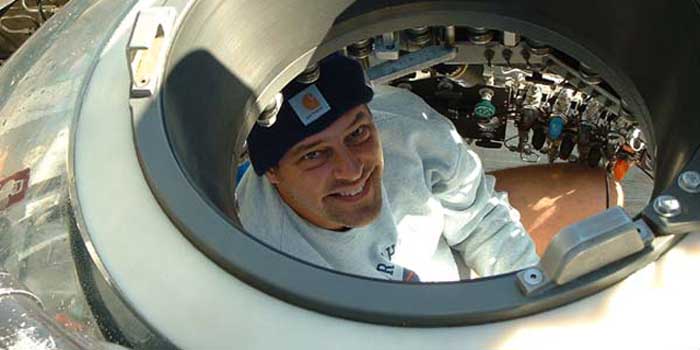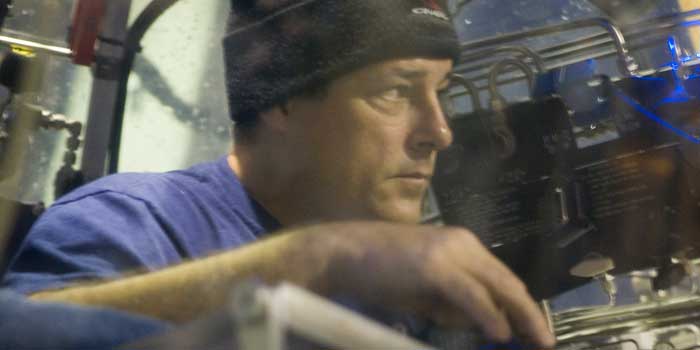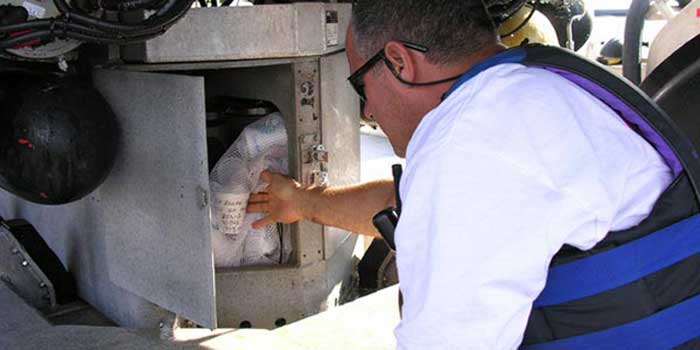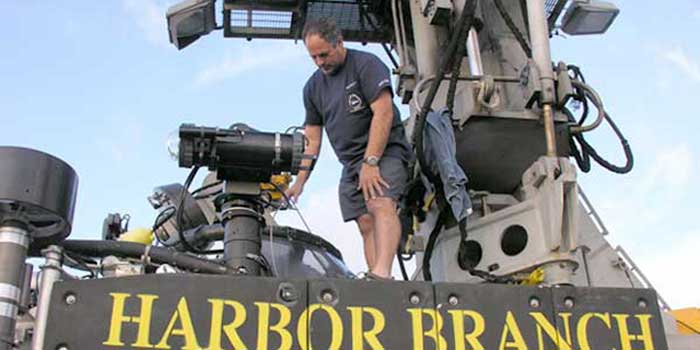Hugo Marrero: Video Transcript
Hear Hugo shares his experiences and the path that led him here. Download (mp4, 442 MB).
Introduction
My name is Hugo Marrero, my title is submersible pilot, I work for the Harbor Branch Oceanographic Institute here in Fort Peirce, Florida. My primary job you can split it between two percentages, I would say that 70% of the work is here at Harbor Branch and what we do is make sure that the submersible is maintained properly and is operational. What we do is prepare for a mission for example a scientist might come in and we meet together and they decide what type of scientific equipment they are bringing on board, what kind of research they are going to do and see if there are any specific requirements for the submersible, then we make sure that all of those requirements are met for the mission—we have to make sure that we carry spare parts and things like that.
I think one of the most thrilling things I've ever seen on the bottom, I've had over 50 submersible dives to the deep sea floor, maybe over thirty ROV dives, and I think... when I first think about it, I think about the most exciting moment when I first saw the bottom for the first time. I just spent a year studying these communities at hydrothermal vents. I mapped the seafloor and knew right where they were. I was ready to see what had changed over the past year and I went down and I dove and I saw it immediately and it was like my own backyard and it was thrilling. That's not the most thrilling story to tell somebody, because it's a personal story. But there have been other things. We actually, one time, saw an octopus die on the seafloor which is very unusual. We sat there and we watched it expire which is very strange in some ways. And then we saw crabs come in immediately and start to chew on him and tear at him.
The rest of it is the diving. When we go out to sea we make sure that we are taking the scientists safely to their work location and to do what it is they are there to do—whether it is setting a piece of equipment or recovering a piece of equipment—at this point we are doing what we call the fun part of the work.
What I enjoy most about being at sea is being right in the water—to me that is the 1% of the job that makes the rest of it. You get to see things that you know probably less than a fraction of less than 1% of the people on Earth have experienced that first-hand. There are also incredibly talented people around you and you are constantly learning something. I always like to go around to the scientists, look over their shoulder and ask 'what are you doing?' 'what is your main research?' Whenever we go out I follow them to the labs and see what they are doing, this also helps me help them do their job. If I know what they are looking for I am more capable of providing them with help.
So working around great people, the food is always good, I can't complain about the food, the comradery that have among all of us working at sea are all great parts of the job.

While at sea, Hugo Marrero is responsible for getting scientists and equipment safely to their undersea work locations.
Being A Submersible Pilot
My primary responsibility is to take the scientists safely to their work location. I need to ensure that they are safe, that the submersible is safe, and that the environment is safe because if we don't focus on the safety first and worry too much about the work its not good. If you are the bottom and you are not watching the environment around you, you could get trapped on the bottom, or you could have a failure and then you have to cancel the research for the day—or even the entire research for the mission if the failure is catastrophic. So our primary function is to make sure that they are safe, the submarine is safe, the secondary function is to support the scientists in whatever it is that they need to carry out their primary research.
The hardest part of the job is to take people safely. Safety to me and to all of my peers is the most important thing. You are taking people to a very hostile environment, you are taking people down three thousand feet in the middle of the ocean, and if you for a second get lacks on safety is when accidents can occur. I mean going underwater and driving the submersible is easy, the hard part is that you have to keep track of things that could go wrong; your scrubber could go bad, you may have an oxygen leak, you may have a water leak inside the submersible, there is always a possibility of smoke in the cabin, there is the possibility of somebody getting sick, having a heart attack because we take people of all ages (adults anyway) and safety is the most important thing to me. We work just like a sports team, if the team is not united and cohesive things just don't happen. We all have a specific function, for example I am in charge of all of the electrical and electronic systems on the submersible, other guys are in charge of mechanical maintenance, other people are in charge of the management of the operation and as we work together offshore, especially at sea we pretty much know what we have to do, there is very little talking because there isn't much time to talk when things are moving. We already have, for example, a set of words that we use when we are on the radio—and you try and keep your talking to a minimum in that in that way everybody know what is going to happen. It is like an act on a scene or in a movie—everybody knows when it is their part, when they come in and almost without any direction, although there is a director, which is the operations director and he is the one that says okay next, next, next.
For example the launch of the submersible, the diving and recovering there are key words. The underwater communications are not always clear, but if you are always using the same language, just like a director does you know what is going on, you know exactly what they meant when you heard it. On the surface the most dangerous part is the recovery, when you are recovering you have a ship that is moving, a swimmer that has to come in, you have the crane operator, all of those guys have to work together and in unison. If anything goes wrong it could be the life of one or more persons at stake—so it's very important that we all work in a team.
What I have always brought into the picture, what I can bring into the diving process is accumulated expertise that I have gained throughout the years. The electronics are a never-ending quest of learning because electronics change so frequently. We have been able to upgrade the submersible a few times and improve the safety. Also the experience I brought in from working the tourist submersibles—safety was also the number one issue—in this one you are taking every-day people down in submarines—even though you are not going that deep you are still underwater and things can go wrong. So the expertise, the combined expertise from these two experiences has been an asset that I have brought to the dive process.

Hugo Marrero discusses the many challenges of piloting submersibles at sea.
More on Being a Sumbersible Pilot
There are many challenges, the challenge of being away from your family. Some years depending on how heavy the work load we may be working three to eight months at sea—not all consecutive but your still away for that time—and so is the rest of the crew. So whenever you are in a situation where you are keeping people away from their families in a different environment at sea—it can be tough for everybody. Normally it takes a certain kind of personality, you know what you are getting into, you know the purpose of you being there, and you do what you are supposed to do.
The other aspect of things that are challenging is when things go wrong. You always do your best to preimpt what things could go wrong, like what spare parts we should bring, but you can't possible bring everything on board because there is a limited amount of room. So when something goes wrong you don't have the right part you can't just go to a store and buy what you know when you are 200 miles at sea—and the customer is paying $35,000.00 dollars a day for you to do the work for them—so sometimes you have to use your creativity to make do and to make things work when you have to. Its kind of like show business—the show must go on and you have to do whatever it takes to get it done.
When working at sea you cannot control the weather and this is always going to make things more difficult and potentially unsafe. Whenever the weather gets tough you can see everybody gets more tense—and more not apprehensive but more alert—and you have to be quicker to react. We have had occasions when the weather has been very rough when the submersible is coming up, and the weather can change from flat calm to 6 to 10 foot seas within an hour. Sometimes we have gone down and everything was okay and by the time you come up you may have 6 to 8 foots swells and remember you have to put a person in the water. When that person is in the water it is very tough for that person that is recovering the submersible because he is the one outside, not only exposed to the weather but exposed to all of the dangers, of the boat moving and heavy equipment all around him—that is always very hairy—everybody is on the edge. Fortunately we have always been able to recover the submersible safely.
It's not an easy career, just like most jobs there are things that are not so glorious, there are times when we all get dirty. Let's say a battery fails, the battery is immersed in oil, the oil gets very nasty, there could be acid on it. When things get flooded they corrode and they get muddy, we have pictures of all of us covered in dirt. Sometime we have to work 20 hours straight to get the sub running, so of course there are some part of the job which are not glorious, but nevertheless there is always the satisfaction that you are capable of contributing to the success of a mission.

Hugo Marrero shares his experiences as a submerisble pilot.
Submersible Pilot Experiences
The most rewarding experience, of course there are many, because to me in every opportunity to get underwater you always find something that is new and that is always rewarding. But the first time I got into this section of the Gulf of Mexico is called a brine pool, its basically a lake in the bottom of the ocean. It is salt water that is super saturated with salt and is basically so dense that it does not mix with the other water. I remember seeing it for the first time, as you approach it looks like you are in some other planet trying to land—because it all looks pretty foreign. When you actually touch the water you can see it undulate just like if you were to hit water on the surface. The submersible once it hits that water, it does not go any further, the submersible does not have the power to penetrate that density. The type of marine life that is around it, all the clams, the tube worms—they are all fascinating. Also there is an area around that zone that has mud volcanoes and it is basically brine that is coming from the bottom. At one time we had a scientist that had left a thermister which is a devise that measures temperature for over a year, he had left it with a stick about three feet long with a 10 foot line attached to a bouy—well the next year we came back to recover it and we could not find it. The mud volcano was so active that it grown to cover the area where we had left the thermister. We kept looking and looking, remember we were trying to find an object that is maybe a few inches in the bottom of the ocean so its not an easy task—you may have coordinates but you are not always in the exact position so we kept looking and looking and we went right to the middle of the volcano with very little visibility and at one point we see a little flash of color and it was the tip of the bouy and that is how we found the theromister so the sediment had come up about 10 feet at that point—we were lucky to find it and of course the scientist was happy because he had given up all hope of finding his equipment and it would be one year of data that would be lost so he was extremely happy.
During Deep Scope 2005 our mission was to take different scientists doing unrelated research one of them was a scientist and he had developed these lights for underwater that are of a certain light frequency in the light spectrum, when you put these lights underwater. With the naked eye you tell much except that the color is different—but then they developed these special glasses and they look like those special glasses you wear in the movies—we thought it was kind of funny you know in the beginning we were like this is kind of dumb you know—we put on the glasses and when you put on the glasses it is a completely different world because there are certain animals that have certain pigment on their skin with reacts with that light and they floresce, they produce light and it was incredible the first time I dove and we could see what things reacted to the light or not. You can detect a little worm that was maybe an inch and a half long 20 or 30 feet away from the sub; we would go there take video and get close-ups and then we collect it. The most interesting one was we found a shark, I believe it was a Leopard Shark, they're very small they're maybe about 18 inches long. This shark had an incredible display of colors from the florescent lights, we took video and we collected him. It was fascinating to see this little shark that had these colors when these light were shined on them.
Another very memorable experience was right after hurricane Katrina we were in the Gulf of Mexico. Katrina came in and we moved into Galveston, Texas, we were on the docks for about a week and Edy's camera had stayed underwater because we couldn't recover it, so we come back and we try to look for the camera. I was not the diver that recovered it that day—somebody else recovered it but then we put it in the water once more and it was a dive where I had to go and recover it and it was unbelievably difficult—the visibility was maybe 10 feet at best. The currents were still strong, remember it was only a week after Katrina and the camera was set up in an area where the bottom was not flat—there are undulations of sand and sediment on the bottom and it took us almost two hours to find the camera we were just going back and forth and even with the sonar we could not find the camera—when we finally found it, it was so difficult to dock the camera to the submersible that we used just about all of the power we had and at one point when I realized we were just about out of power I told the scientist that this is it—we either pick it up now or it stays here and fortunately we were able to lock the camera but not completely we were able to use the manipulator arm—I remember calling that the dive from hell—It was just so tough, it was one of the toughest ones for me particularly because of the difficulty of trying to work in no-visibility conditions.

Hugo shares his career journey that led him to this position as submersible pilot at Harbor Branch Oceanographic Institute.
Career Path
As for my career path, I never thought I would be doing this even though I always dreamt about it. My training is in electronics I have an associates degree in electrical engineering and I started working in electronics. My hobby was always SCUBA diving, surfing, doing anything that had anything to do with the water. I had moved to California to do some work for some of the big corporate companies in Silicon Valley and while I was there I was reading a magazine, a known magazine "Skin Diver" magazine and I saw a little ad talking about a little college in Santa Barbara, Santa Barbara City College and I thought 'that sounds interesting' I decided to take a trip down to Santa Barbara, I took a few days off of work, drove down there, talked with the teachers, saw what they did—I was hooked, I was fascinated, I decided right then that's it. I quit my job, sold everything I had, moved to Santa Barbara. Ever since I left that school in 1991 I have been working with submarines. While I was there I was hired to work with a tourist operator in Hawaii, so I worked in Hawaii, the Bahamas, the Cayman Islands. While I was working in the Cayman Islands I decided to apply for Harbor Branch. I was fortunate enough to be hired in 1996 and it has been a great experience.
Published September 3, 2018
Return to profile